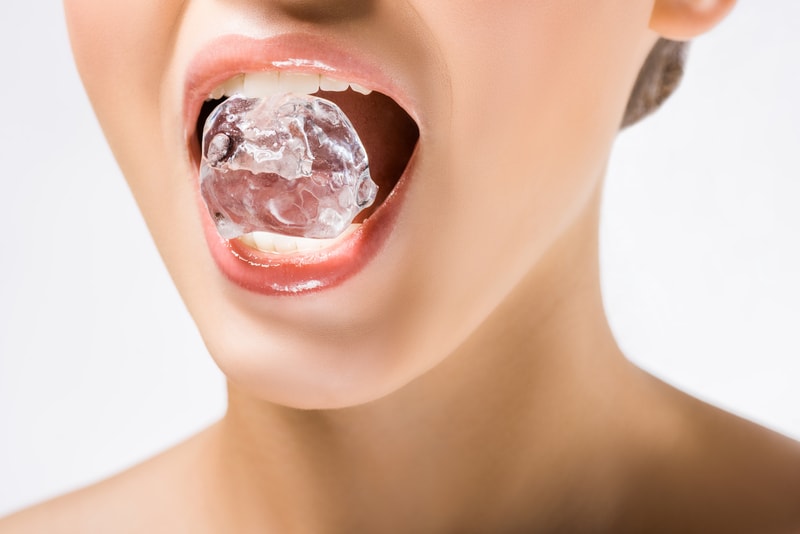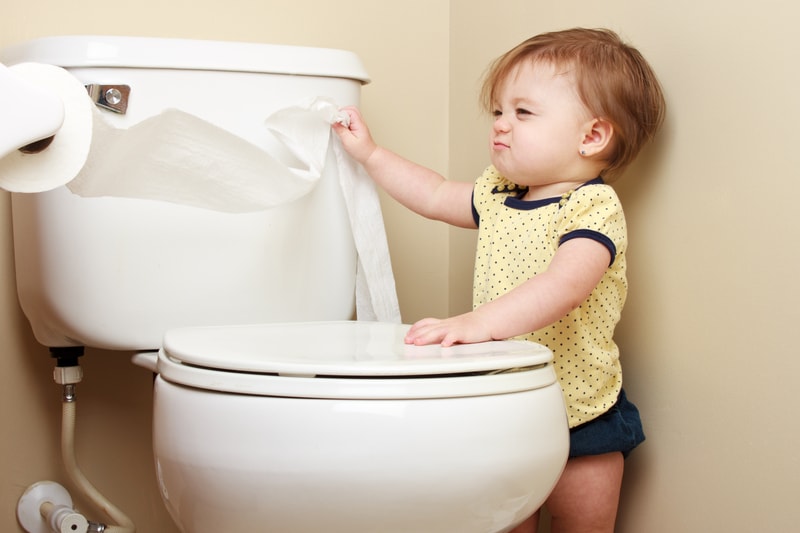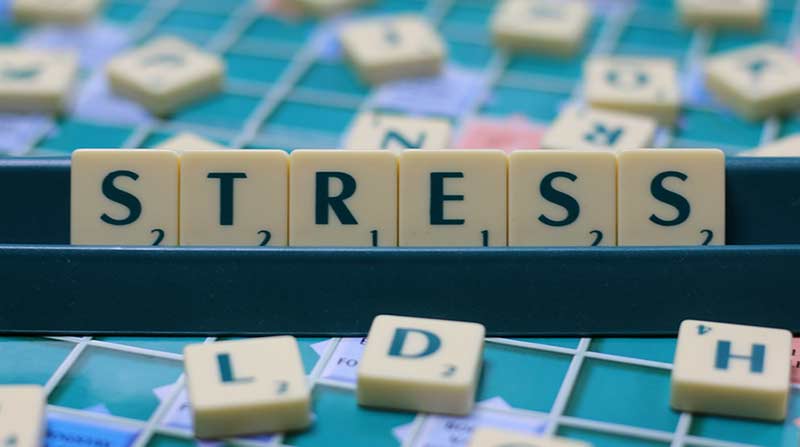You use it to eat, talk, and express your emotions. Without it, you wouldn’t even be able to open and close your mouth. The temporomandibular joint (TMJ) is one of the most underappreciated parts of our body despite how much we rely on it from day to day. With stress and anxiety levels at an all-time high, more and more people are experiencing jaw pain due to TMJ dysfunction. Other than reducing sources of stress and over-the-counter pain medications, there’s no quick fix for this issue. However, acupuncture and acupressure have become more popular options for the long-term treatment of TMJ. In this article, you’ll learn how you can benefit from them and how to use TMJ acupressure points in your treatment regimen.
Can Acupuncture Help TMJ?

Horrible migraines. Pressure in the ears. Tinnitus. Teeth grinding. Locked jaw. Clicking and popping in the jaw. Do any of these sound familiar? These are some of the symptoms you could experience with TMJ. It can be caused by stress, injury, arthritis, tumors, and nerve problems. Usually, it is treated by reducing stress, avoiding foods that are difficult to chew, taking painkillers, or surgery. However, sometimes these methods don’t work, which is why acupuncture is slowly on the rise as an alternative treatment for TMJ.
Acupuncture is the traditional Chinese medicine (TCM) practice by which a licensed professional inserts needles at different points in the body (also known as acupressure points or acupoints) to help facilitate healing and balance. It operates under the belief that qi (energy) flows through channels around the body. Sometimes this flow of energy can get blocked or imbalanced, which results in disease, pain, and other abnormalities. Acupuncture helps to restore this flow and, as a result, helps you feel better. In the care of an experienced professional, rarely do any complications occur.
Acupuncture can be helpful for everything from menstrual cramping to TMJ. And the principles under which this practice operates are not too far off from the science behind it. It is believed that the insertion of needles causes the body to release various chemicals that could play a role in the pain-reducing effect of acupuncture. While the research so far backs up this claim, acupuncture is still considered a controversial therapy.
Is Acupuncture Effective For TMJ?
Acupuncture is commonly used for TMJ pain, which is a deficiency in qi in the liver meridian and an excess of qi in the gallbladder. Acupuncturists usually treat TMJ acupressure points. These acupoints can be close to the joint itself, but because all of the energy channels are connected to each other, you may find that they will also treat points near the elbows, knees, and big toes. Although it may seem strange, these distal points indirectly correct the overall flow of energy to help reduce stress and other factors that could play a role in TMJ dysfunction. In a 2017 review of several studies on the effectiveness of acupuncture on TMJ, it was found that overall acupuncture is effective in minimizing jaw pain, especially in those who also had myofascial pain.
Can Acupuncture Cure TMJ?

While our discussion so far shows some promise in acupuncture treatment, there is still no guarantee that it can cure TMJ, if at all. It is possible that TMJ could go away with treatment, but it can also depend on the origin of the disorder to begin with. Acupuncture cannot correct anything such as disc displacements or degeneration or other structural abnormalities that might have caused the TMJ, just the pain and discomfort resulting from it. Given that it is a low-risk treatment option, there is no harm in pursuing it. However, you should not go into acupuncture treatment thinking that it is the end all be all when it might not be. Most doctors only recommend acupuncture therapy as a complementary treatment rather than a sole one.
How To Relieve Headaches Caused By TMJ

If you’re terrified by the thought of needles or are not ready to commit to acupuncture, you can also consider trying acupressure for TMJ. Acupressure is just as effective treatment as acupuncture but without the hassle of needles. Instead, you massage or apply direct pressure to TMJ acupressure points either by yourself or with the help of a professional. Like acupuncture, the research on acupressure is still growing but shows potential. A study in 2010 showed that acupressure treatment for chronic headaches was more effective than muscle relaxants after one month.
To perform acupressure for TMJ headaches, you should learn the proper technique so that you can get the most out of self-treatment. Follow the steps below to get started:
- Find a comfortable area to sit – Before you perform acupressure for TMJ, make sure to find a space in your home where you can comfortably sit and do this technique. Ideally, your environment should help you relax.
- Identify the TMJ acupressure points – Below, you’ll find a list of recommended TMJ acupressure points to treat. After you’ve studied these, try to identify them on your own body.
- Apply pressure to each acupoint, then massage – Pick one acupoint and begin by applying direct pressure to it with your fingers for 10-15 seconds. Then, massage in a circular motion for another 10-15 seconds. It might be somewhat uncomfortable but not painful. Make sure to avoid bruises, sores, or open wounds, as this technique could worsen or further irritate these areas.
- Repeat as needed. Continue to work on each acupoint as needed. The best part about doing self-acupressure for TMJ is that it can be done anytime and for however long you want!
How To Fix Lock Jaw Immediately

Along with headaches, acupressure can also help with any TMJ pain, clicking, locking, or tension. It is especially helpful if you’re in a pinch and can’t get to a licensed acupuncturist when you’re in pain in the moment. To fix the lockjaw immediately, you can follow the above steps to perform acupressure for TMJ and do some of the jaw exercises detailed below:
- Jaw relaxation – Bring your tongue to the roof of your mouth and place it behind the upper front teeth. Open and close your mouth a few times. You can also press your finger in the area in front of your ear on the TMJ and use the other fingers to open and close your mouth.
- Chin tucks – First, stand against a wall. Then, pull your chin inwards to create a double chin. Hold this position for three to five seconds and repeat.
- Mouth resistance – Place your thumb under your chin and begin applying pressure as you open your mouth. Hold for three to five seconds and then close your mouth.
7 Acupressure Points For TMJ
Acupoint: SI-19 (Other Names: Small Intestine-19/Ting Gong/Palace of Hearing)
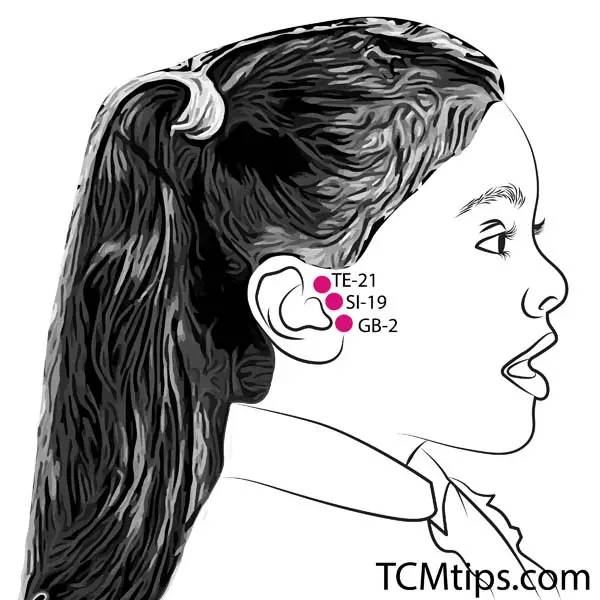
SI-19, also known as “tinggong” or “palace of hearing”, is located in the area in front of the ear. You can find it by locating it in the depression formed when opening your mouth. This is one of the main acupoints treated for TMJ. However, it is mainly known as one of the acupressure points for earache and other ear problems such as deafness, tinnitus, and hearing loss.
Acupoint: GB-2 (Other Names: Gallbladder-2/Ting Hui/Meeting of Hearing)

GB-2, also known as “tinghui” or “meeting of hearing”, is located just below SI-19 in front of the ear. It helps relieve pain from TMJ disorder by eliminating wind locally. Like SI-19, the gb 2 acupuncture point is also one of the primary targets for ear issues like tinnitus and deafness.
Acupoint: TE-21 (Other Names: Triple Energizer-21/Er Men/Ear Gate)
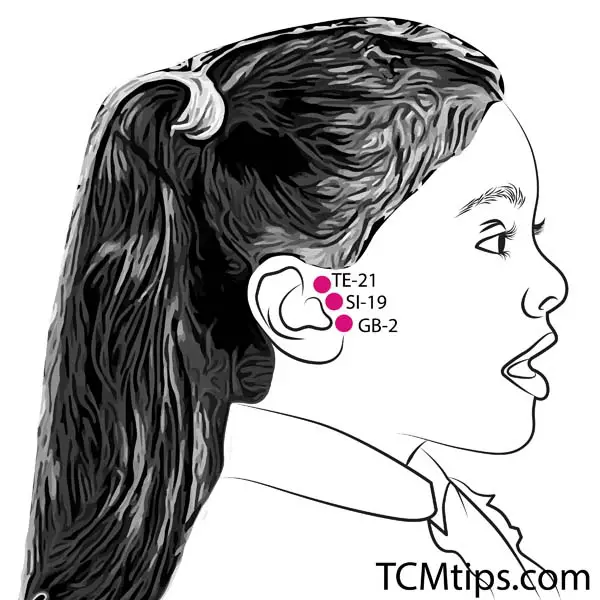
TE-21, also known as “ermen” or “ear gate”, is located in front of the ear above SI-19. Treat this acupoint for TMJ problems and upper jaw toothaches. Otherwise, it is also known as one of the eustachian tube pressure points to treat congested ear and ear drainage.
Acupoint: ST-7 (Other Names: Stomach-7/Xia Guan/Below the Arch)
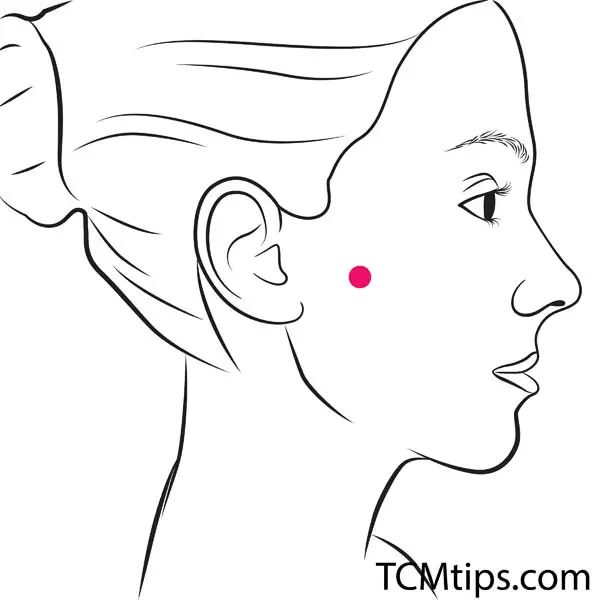
ST-7, also known as “xiaguan” or “below the arch”, is located in the depression between the zygomatic arch and the condyloid process of the mandible. ST-7 is ideal to treat if you’re having difficulty opening your mouth or have facial pain as a result of TMJ. It is also known as one of the acupressure points for tooth pain.
Acupoint: GB-3 (Other Names: Gallbladder-3/Shang Guan/Above the Joint)

GB-3, also known as “shangguan” or “above the joint”, is located in front of the ear in the depression on the upper border of the zygomatic arch (see the diagram above). It is extremely effective at dispelling wind and relieving pain in TMJ disorders. Other clinical indications include headaches, tinnitus, and deafness.
Acupoint: TE-17 (Other Names: Triple Energizer-17/Yi Feng/Wind Screen)
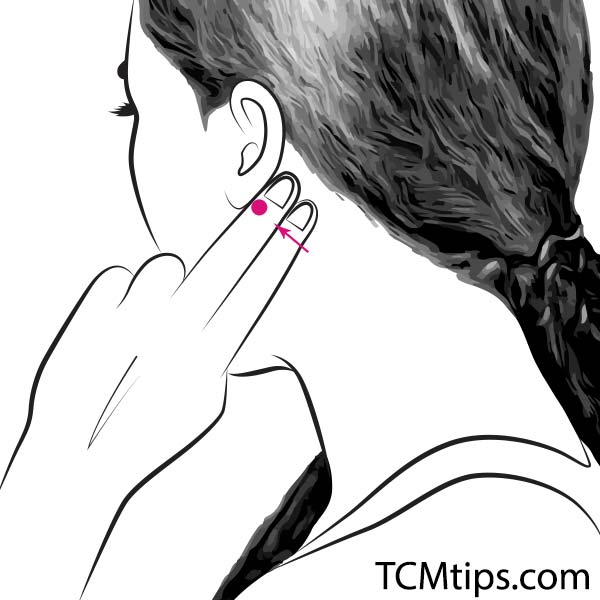
TE-17, also known as “yifeng” or “wind screen”, is located two fingers behind the earlobe. TE-17 improves TMJ dysfunction by dispersing wind and clearing the channel. If you also suffer from bruxism, you can also be treated with acupuncture for teeth grinding by a licensed professional.
Acupoint: ST-6 (Other Names: Stomach-6/Jia Che/Jaw Bone)
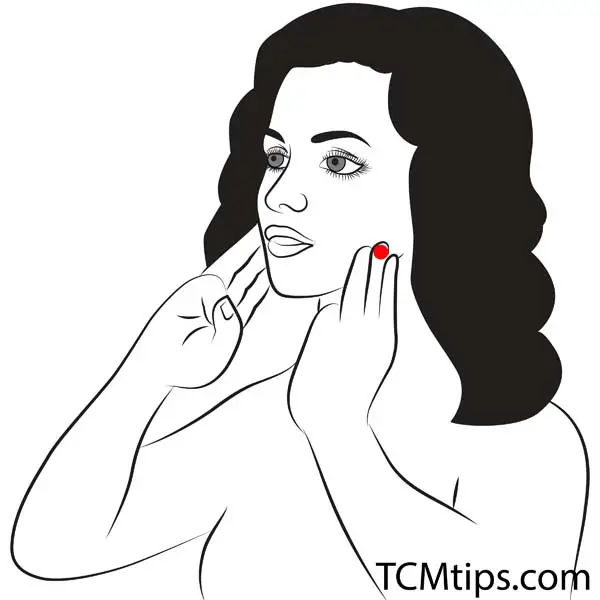
ST-6, also known as “jiache” or “jaw bone”, is located on the cheek where your muscles are most prominent when your teeth are clenched. It is a great point for headaches relief caused by TMJ as it dispels wind, clears blockages in the meridian, relieves pain, and overall benefits the jaw. ST-6 is also one of the 10 best acupressure points for weight loss.

Try our Anti-Aging Gua Sha Tool designed to bring out your skin’s natural glow.
Best Gua Sha Product- Anti-Aging: The tool is designed to target 11 specific aging signs such as wrinkles and sagging skin. By following the 7-step routine, users can improve skin firmness and reduce fine lines naturally.
- Enhances Skincare Routine: It works effectively with serums and lotions, boosting absorption and efficacy of skincare products.
- Visible Skin Improvement: Users can expect a smoother complexion, reduced puffiness, and a more youthful appearance.
 P. Sze
P. Sze 